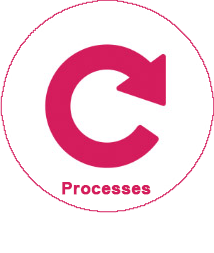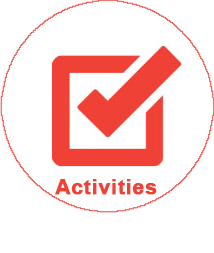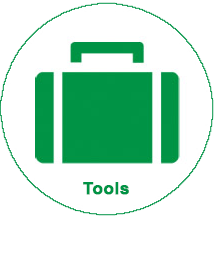The CA-PMF includes text that describes the key roles and responsibilities that are involved during each process phase. This content is broken down below in a table format for ease of reference.
 Concept
Concept-
The following table identifies primary participant roles and responsibilities for this process phase. In some cases, a project might have unique requirements that call for additional roles or responsibilities depending on the project’s size, type, and complexity.
Definitions of all roles referenced in the CA-PMF is provided in the Project Role Definitions section in the Additional Resources chapter.
Role
Responsibilities
Executive Sponsor(s)
Provides agreement for funding the project.
Provides executive intervention to overcome organizational roadblocks.
Key to assuring the project goals and objectives align with the organization’s strategic direction.
Project Sponsor
Key to assuring the project goals and objectives align with the organizations strategic direction.
Key to allocating initial resources needed to complete the necessary tasks in the Concept Process Phase.
IT Sponsor
Provides technical information that may be required to complete tasks in the Concept Process Phase.
Business Owner(s)*
Provides information pertaining to a preferred product or solution.
Communicate high-level requirements.
Stakeholders
Any person or group with an active interest in the project outcome or process and wishes to participate, or is invited to participate, in the tasks associated with the Concept Process Phase, including SMEs.
* May also be referred to as Business Sponsor.
 Initiating
Initiating-
The following table identifies primary participant roles and responsibilities for this process phase. In some cases, a project might have unique requirements that call for additional roles or responsibilities depending on the project’s size, type, and complexity.
Definitions of all roles referenced in the CA-PMF is provided in the Project Role Definitions section in the Additional Resources chapter.
Role
Responsibilities
Executive Sponsor(s)
Keep project aligned with organization’s strategy and portfolio direction.
Provide leadership on culture and values.
Provide escalation path for project risks and issues.
Ensure continuity of sponsorship.
Work with other sponsors.
Focus on realization of benefits.
Provide assurance to the project team by communicating executive-level support.
Provide feedback and lessons learned.
Project Sponsor
Identify the Project Manager.
Identify key business objectives and criteria for success.
Provide escalation path for project risks and issues.
Identify Stakeholders including Business Owner(s).
Identify members of the planning team.
Contributes to and approves the Project Charter.
Contributes to and approves the preliminary Project Scope Statement based on a clear business problem, need, or opportunity.
Contributes to and approves the Project Organizational Chart and RACI Matrix.
Develop the preliminary Project Staffing Estimate.
Communicate with the business organization, executive management and external Stakeholders about the plans for the project.
Understand the project scope and its relationship to the organization’s strategic plan.
Participate in a Kick-Off meeting to establish and introduce the project team.
Demonstrates commitment to the project.
Stakeholder(s)
Any person or group that has an active interest in the project outcome or process, and wishes to participate, or is invited to participate, in the tasks associated with the Initiating Process Phase. This includes SMEs.
IT Sponsor
Provide input to the Project Sponsor regarding the Project Charter.
Assure that the project fits within the organization’s IT strategic goals and priorities.
Assist in identifying other key IT Stakeholders within the organization who may have future responsibilities for implementing and operating the functionality created by the project.
Review and provide feedback regarding the draft Project Organization Chart.
Support the Project Manager and Project Sponsor in the preparation of the preliminary Project Scope Statement.
Review and provide feedback to the RACI matrix.
Review and provide feedback to the project staff estimates.
Business Owner(s)*
Provide input into drafting the Project Charter.
Define the business outcomes and measurable objectives.
Provide input into drafting the Preliminary Scope Statement.
Provide input regarding business resources committed in the preliminary Budget Plan.
Assist with identifying Stakeholders and review the Stakeholder Register.
Project Manager
Leads the development of the Project Charter.
Review project concept in relation to the organization’s strategic business and IT goals and priorities.
Provide status updates to the IT Sponsor, Project Sponsor and other Stakeholders.
May perform high-level analysis of early project risks to complete the Project Scope Statement.
Assist with developing project staffing and resource estimates.
Help to define and document project roles and reporting relationships in a RACI Matrix.
Conduct Stakeholder Analysis and create Stakeholder Register.
Department of Technology (CDT)
Provide input, guidance, approval/disapproval of the project.
* May also be referred to as Business Sponsor.
 Planning
Planning-
The following table identifies primary participant roles and responsibilities for this process phase. In some cases, a project might have unique requirements that call for additional roles or responsibilities depending on the project’s size, type, and complexity.
Definitions of all roles referenced in the CA-PMF is provided in the Project Role Definitions section in the Additional Resources chapter.
Role
Responsibilities
Executive Sponsor(s)
Provides executive intervention to overcome organizational roadblocks. Key in driving the project goals and objectives to align with the organization’s strategic direction.
Project Sponsor
Provides overall direction during the planning process.
Approves the Project Management Plan (PMP and subordinate plans).
Coordinates with all sponsoring organization Stakeholders as the project takes shape.
Establishes and maintains communication with external Stakeholders.
Participates in identification of risks.
Oversees the establishment of governance processes and structures.
Ensures the project obtains the resources needed to proceed with project planning.
Clarifies priorities among schedule, cost, and project scope.
Ensures timely resolution of project issues.
Reviews and approves materials submitted for project approval.
Reviews and approves funding documents.
Advocates for project funding and approval.
IT Sponsor
Participates in the development of the PMP and subordinate plans.
Participate in the development of system requirements and the traceability matrix.
Participate in the development of funding documents.
Provides IT expertise for planning activities.
Business Owner(s)*
Participates in drafting the PMP and subordinate plans.
Identifies and engages SMEs.
Participates in planning processes, especially those related to the sponsoring program. Examples include defining functional requirements, Stakeholder analysis, procurement planning, communication planning, and risk identification.
Project Manager
Leads the preparation of the PMP and subordinate plans.
Oversees implementation of the plans.
Establishes governance processes and structures.
Coordinates development of the requirements documents.
Leads Stakeholder analysis and management of Stakeholder activities.
Forms teams and begins work to define scope, schedule, and cost.
Reviews all applicable state IT standards and regulations to ensure compliance.
Participates in collaborative reviews.
Oversees development of funding documents.
Facilitates development of an initial risk registry.
Initiates kickoff meeting(s) with the project team, Stakeholders, and Project Sponsor(s).
Project Team
The group responsible for planning and executing the project.
Works with necessary Stakeholders and staff.
Delivers their tasks according to the project schedule.
Contract Manager
Responsible for managing and tracking vendors.
Provide oversight and tracking for the system integrator contract and other project-related contracts.
Participates in negotiations
Facilitates amendments.
Reviews work authorizations and invoices.
Monitors contract compliance.
Information Security Officer (ISO)
Responsible for security throughout the sponsoring organization.
Works closely with the project team to ensure project operation and product development have appropriate protection of confidential data, are secure against unauthorized access, and that any breaches are reported according to state and federal requirements.
Subject Matter Experts (SMEs)
Assist in developing functional requirements.
Assist in Stakeholder identification and analysis.
Assist in defining scope, schedule, and cost.
Department of Technology (CDT)
Oversees the PAL.
Provides support and advice regarding project management activities.
Provides support for or conducts IT procurements.
Department of Finance (DOF)
Reviews project funding documents.
Gains funding approval by Legislature.
* May also be referred to as Business Sponsor.
 Executing
Executing-
The following table identifies primary participant roles and responsibilities for this process phase. In some cases, a project might have unique requirements that call for additional roles or responsibilities depending on the project’s size, type, and complexity.
Definitions of all roles referenced in the CA-PMF is provided in the Project Role Definitions section in the Additional Resources chapter.
Role
Responsibilities
Executive Sponsor(s)
Provides agreement for executive intervention to overcome organizational roadblocks.
Key to driving the project goals and objectives to align with the organization’s strategic direction.
Project Sponsor
Key to driving the project goals and objectives to align with the organization’s strategic direction.
Key to resolving escalated issues related to the Triple Constraint: scope, schedule, cost, and quality.
IT Sponsor
Provides technical information, resources, and support to complete tasks in the Executing Process Phase.
Business Owner(s)*
Provides information pertaining to a preferred product or solutions.
Able to validate that requirements are met.
Project Manager
Responsible for directing, managing, monitoring, controlling, and communicating all work associated with the project outcome.
Stakeholder(s)
Any person or group that has an active interest in the project outcome or process, and wishes to participate, or is invited to participate, in the tasks associated with the Execution Process Phase.
At this point in the project, a Stakeholder is usually receiving project status reports.
Department of Technology (CDT)
Provides input and guidance and receives updates on the project status and/or project activities.
Department of Finance (DOF)
Provides input and guidance and receive updates on the project status and/or project activities.
Project Support Staff
Supports the project with activities as needed during the Execution Process Phase of the project.
Solutions Vendor
A contracted company that provides goods or services in support of the project.
* May also be referred to as Business Sponsor.
 Closing
Closing-
The following table identifies primary participant roles and responsibilities for this process phase. In some cases, a project might have unique requirements that call for additional roles or responsibilities depending on the project’s size, type, and complexity.
Definitions of all roles referenced in the CA-PMF is provided in the Project Role Definitions section in the Additional Resources chapter.
Role
Responsibilities
Executive Sponsor(s)
Provides support, encouragement, and recognition to the project team.
Project Sponsor
Provides sign-off on the final product(s).
Approves transfer of any open issues.
Supports project closing activities.
Ensures appropriate resources are available to conduct closing activities.
Participates in lessons learned sessions.
Participates in project celebration activities.
Assigns ownership of the PIER.
Approves the project for closing.
IT Sponsor
Confirms satisfactory completion of all transition activities.
Approves transfer of open issues accepted by the IT Department.
Supports project closing activities.
Ensures appropriate IT resources are available to conduct closing activities.
Participates in lessons earned sessions.
Participates in project celebration activities.
IT Product Owner(s)
Confirms that all deliverables necessary to operate and support the product are complete and suitable for their intended use.
Project Manager
Leads the project closing effort and ensures all process phase tasks and milestones are completed.
Transition Support Lead
Assists the IT System Owner with transitioning products or completed deliverables to the M&O organization. Project Support Staff
Supports the Project Manager with project closing activities.
 Post Launch Support
Post Launch Support-






